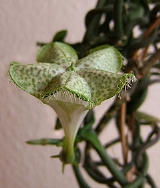
Ceropegia sandersonii
Encyclopedia
Ceropegia sandersonii is a flowering plant
in the genus Ceropegia
(Apocynaceae
), native to Mozambique
, South Africa
, and Swaziland
. Common names are Parachute plant, Fountain flower, and Umbrella plant.
Ceropegia sandersonii is a prostrate, slender twinner, nearly hairless, with sparse, succulent leaves. The roots form narrowly fusiform clusters. The distinctive greenish white funnel-shaped (having a corolla-tube) flower
s are 5–7 cm long and are placed on a delicate stalk. Due the fact that the corolla lobes are partially fused, the opening of the flowers is partially inhibited. The tips of the petals do not separate and form a roof or umbrella-like dome on the flower, while the fused bottom forms the tube. The openings between the petals are also referred to as windows, hence the name windowed flowers that is also used for flowers of this type (Weberling, 1992). The flower itself serves as a biological myiophilous (fly-pollinated) pitfall-trap, that traps flies when they descent into the corolla tube. Small hairs that are pointed downwards prevent the insect from escaping. Once trapped, the victim is thoroughly pollinated and only released when the flower is left off and the hairs weaken.
Flowering plant
The flowering plants , also known as Angiospermae or Magnoliophyta, are the most diverse group of land plants. Angiosperms are seed-producing plants like the gymnosperms and can be distinguished from the gymnosperms by a series of synapomorphies...
in the genus Ceropegia
Ceropegia
Ceropegia is a genus of plants within the family Apocynaceae. It was named by Carl Linnaeus, who first described this genus in volume 1 of his Species plantarum, which appeared in 1753. Linnaeus thought that the flowers looked like a fountain of wax. From this the scientific name was derived:...
(Apocynaceae
Apocynaceae
The Apocynaceae or dogbane family is a family of flowering plants that includes trees, shrubs, herbs, and lianas.Many species are tall trees found in tropical rainforests, and most are from the tropics and subtropics, but some grow in tropical dry, xeric environments. There are also perennial herbs...
), native to Mozambique
Mozambique
Mozambique, officially the Republic of Mozambique , is a country in southeastern Africa bordered by the Indian Ocean to the east, Tanzania to the north, Malawi and Zambia to the northwest, Zimbabwe to the west and Swaziland and South Africa to the southwest...
, South Africa
South Africa
The Republic of South Africa is a country in southern Africa. Located at the southern tip of Africa, it is divided into nine provinces, with of coastline on the Atlantic and Indian oceans...
, and Swaziland
Swaziland
Swaziland, officially the Kingdom of Swaziland , and sometimes called Ngwane or Swatini, is a landlocked country in Southern Africa, bordered to the north, south and west by South Africa, and to the east by Mozambique...
. Common names are Parachute plant, Fountain flower, and Umbrella plant.
Ceropegia sandersonii is a prostrate, slender twinner, nearly hairless, with sparse, succulent leaves. The roots form narrowly fusiform clusters. The distinctive greenish white funnel-shaped (having a corolla-tube) flower
Flower
A flower, sometimes known as a bloom or blossom, is the reproductive structure found in flowering plants . The biological function of a flower is to effect reproduction, usually by providing a mechanism for the union of sperm with eggs...
s are 5–7 cm long and are placed on a delicate stalk. Due the fact that the corolla lobes are partially fused, the opening of the flowers is partially inhibited. The tips of the petals do not separate and form a roof or umbrella-like dome on the flower, while the fused bottom forms the tube. The openings between the petals are also referred to as windows, hence the name windowed flowers that is also used for flowers of this type (Weberling, 1992). The flower itself serves as a biological myiophilous (fly-pollinated) pitfall-trap, that traps flies when they descent into the corolla tube. Small hairs that are pointed downwards prevent the insect from escaping. Once trapped, the victim is thoroughly pollinated and only released when the flower is left off and the hairs weaken.

